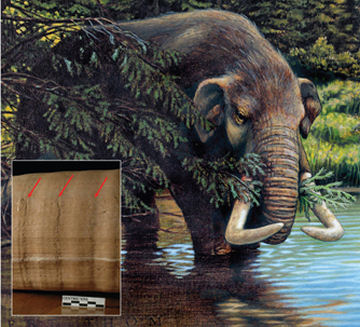Mastodons in Musth: Tusks may chronicle battles between males
Damaged segments on fossils of male mastodons’ tusks hint that the creatures engaged in fierce combat with each other during a specific time almost every year of their adult lives, a new study suggests. That behavior parallels the annual period of heightened aggression and hormone-fueled jousting for mates in modern bull elephants. Scientists call the yearly period musth.

“American mastodons were not just docile herbivores that whiled away their time in forests and meadows,” says Daniel C. Fisher, a paleontologist at the University of Michigan in Ann Arbor. “They were very aggressive animals.”
Mastodons roamed North America from 4 million to 10,000 years ago. When Fisher examined the 11,480-year-old remains of a male mastodon excavated in 1999 in Hyde Park, N.Y., he noticed regularly spaced rows of shallow pits along the undersides of the long, curved tusks. A microscopic look at a cross section of one tusk revealed that the zones of dentin underlying the external pits were also damaged, Fisher reported in Ottawa last week at the annual meeting of the Society of Vertebrate Paleontology.
The lesions seem to originate at the boundary between the dentin and the cementum, the hard outer layer of the tusk. The cells that form new ivory lie along that interface at the base of the tusk, he notes.
The tusk damage always appears in ivory that formed between midspring and early summer of each year after the mastodon reached the age of 20. The ratios of chemical isotopes enable scientists to identify the annual growth patterns in the tusks of mammoths and mastodons.
Male mastodons fought each other in several ways, previous analyses suggested. The most damaging blows may have resulted when one male dipped its head and then swung it upward, thrusting the tip of its curved tusk into the neck or skull of its opponent, says Fisher.
The impact of such a thrust, which could have incapacitated or killed an opponent, would also have jammed the tusk against the lower rim of its socket. That, in turn, would have crushed the ivory-making cells there and caused the scars, Fisher speculates.
“It’s a plausible hypothesis,” says James O. Farlow, a paleontologist at Indiana University–Purdue University in Fort Wayne. However, he wonders why similar features haven’t been reported in the tusks of modern-day elephants.
Today’s elephants have tusks that are only slightly curved, Fisher counters. Any jousting among modern males jams a tusk backward into its socket, not downward, so the impact is absorbed by a ligament that holds the tusk in place.
Fisher has noted similar tusk damage on the remains of a mastodon that was unearthed near Fort Wayne in 1968. However, those lesions appear to have been made only once every 2 or 3 years during the mastodon’s adulthood. The presence of humans in the Fort Wayne area when that mastodon lived may explain that reduced incidence of damage, says Fisher. Hunting may have lowered the number of male mastodons in the region, thereby reducing competition and the frequency of musth battles.







